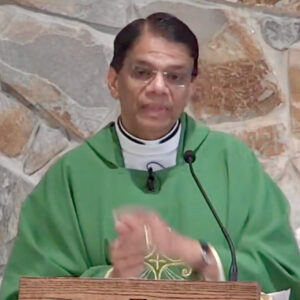Today’s feast marks the Presentation of the Lord Jesus in the Temple, forty days after he was born. As the firstborn, he belonged to God. According to the Law, Mary and Joseph were required to take him to the Temple and “redeem” him by paying five shekels. At the same time, the Law required the child’s mother to offer sacrifice to overcome the ritual impurity brought about by childbirth.
So, the feast we celebrate shows a curious turn of events. The Redeemer seems to be redeemed. She, who is all-pure, presents herself to be purified. Such is the humility of our God. Such is the humility of the Blessed Virgin. They submit to the law even though they are not bound by it.
However, the Gospel story nowhere mentions Jesus’ “redemption,” but seems to describe instead a religious consecration such as a priest might undergo. Saint Luke tells us that Jesus is “presented” in the Temple, using the same verb that Saint Paul uses to describe the offering of a sacrifice. Another parallel is the Old Testament dedication of Samuel to the Temple as a priest. The drama surrounding Jesus’ conception and birth began in the Temple when the Archangel visited Mary’s kinsman, Zechariah the priest. And now the story of Jesus’ infancy comes to a fitting conclusion, again in the Temple.
All the readings today concern Jerusalem, the Temple, and the sacrificial rites. The first reading comes from the Prophet Malachi, who called the priests to return to faithful service and foretold a day when a Messiah would arrive with definitive purification of the priesthood. Christ now arrives as the long-awaited priest and redeemer. He is also the sacrifice. Indeed, as His life will show, He is the Temple itself.
There are lessons we can draw from these readings for our lives today: 1. Reconfirm our commitment to God’s will. Joseph’s and Mary’s obedience in presenting Jesus at the Temple shows the importance of aligning our lives with God’s. 2. Recognize Jesus as the Messiah. Cultivate a life of prayer, reflection, and openness to the Holy Spirit to discern God’s presence and guidance in everyday moments of our lives. 3. Our hope and patience in God’s promises, like Simeon’s declaration, show the reward of waiting faithfully for God’s promises and trusting in God’s timing, maintaining hope even during long seasons of waiting, knowing he fulfills his word. 4. The recognition of universal salvation—Simeon acknowledges Jesus as a light for Revelation to the Gentiles and glory for Israel, emphasizing God’s inclusivity. Embrace a broader vision of God’s work, understanding that his love and salvation are for all people, not just a select group. 5. Endurance through challenges—Simeon prophesied the suffering Mary would face, reminding us that growth often involves trials. Accept difficulties as opportunities for refining faith and deepening trust in God’s purpose. When we have trials and challenges, let us always think about Mary and Joseph. They had gone through all these in their lives. God Bless you all.
Love and prayers,
Fr. Charley
